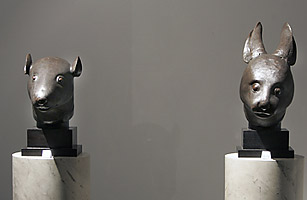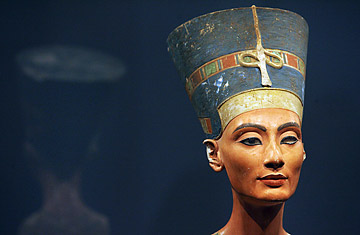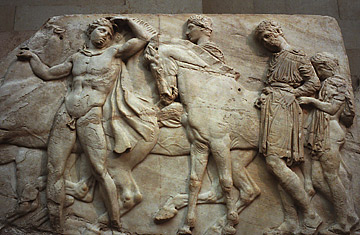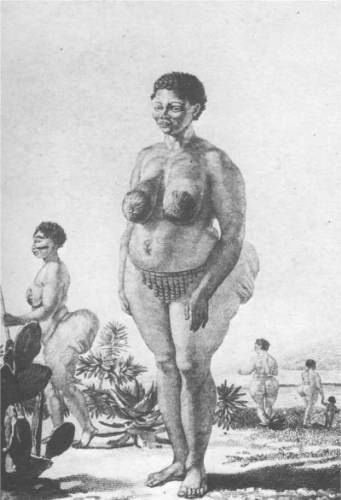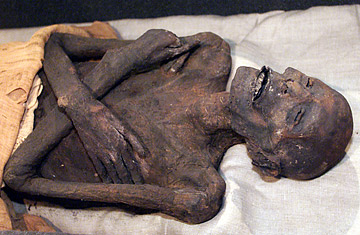Top 10 Plundered Artifacts
世界十大遭掠奪文物
1:中國獸首 Chinese Bronzes
The recent attempt to sell a pair of brass Chinese animal heads took an inventive turn after they were put up for auction as part of the sale of French designer Yves Saint Laurent's art collection. A $40 million bid was received for the two heads (a rabbit and a rat), which French and British troops removed from a clock at China's Old Summer Palace during the second Opium War in 1860. One hitch — the buyer had no intention of paying. Chinese art dealer Cai Mingchao submitted the massive bid to protest the sale of the heads, which many Chinese see as unfairly torn from their cultural patrimony.
當法國設計師伊夫-圣-羅蘭決定將其收藏品進行拍賣后,最近的這次對中國獸首兜售的嘗試有了與以前完全不同的進程。這兩個在第二次鴉片戰爭中被英法軍隊于圓明園搶奪而來的獸首,先是以四千萬美元成交。然后最意外的事情發生了,買家并沒有付款的意思。中國的藝術商蔡銘超重金拍得獸首,僅僅是是為了抗議對兩個獸首的拍賣行為。因為在中國人的眼中,拍賣是對他們文化遺產的不公平的掠奪。
Current Status: Saint Laurent's partner said he plans to keep the heads and is "thrilled" the sale failed. And while Christie's may consider charges against Cai, they will likely relent after an outpouring of support from the Chinese public for his actions.
目前狀況:Saint Laurent's的合伙人宣稱他將會自己保有這兩個頭像,并且他對拍賣的流產表示很震驚。盡管佳士得(拍賣公司)有可能考慮將蔡銘超送上法庭,但面對中國無數公眾對蔡的強大支持,它(佳士得,譯者注)也不得不三思而后行。
2:埃及皇后勒菲綈緹的半身像 Nefertiti's Bust
During a 1912 Egyptian excavation, German archaeologist Ludwig Borchardt discovered the bust of Nefertiti, a 14th Century BC Egyptian queen. He claimed to have an agreement with the Egyptian government that included rights to half his finds and — using this as justification — Berlin has proudly displayed the item since 1923. But a new document suggests Borchardt intentionally misled Egyptian authorities about Nefertiti, showing the bust in a poor light and lying about its composition in order to keep his most-prized find. The Egyptian Supreme Council of Antiquities has repeatedly asked Germany to give the bust back — or at the very least let it return home on a temporary basis.
1912年,在埃及的一個考古挖掘中,德國的路德維格.波哈特發現了公元前十四世紀,埃及皇后勒菲綈緹的半身像。他聲稱,根據他與埃及政府達成的一項協議,他可以擁有他一半的發現(利用此協議為托詞),柏林也冠冕堂皇的從1923年就開始展出這一文物。可是,根據最新發現文件,博哈特在當年在半身像的歸屬問題上,故意的誤導了埃及政府。為了能夠留住最珍貴的半身像,他讓埃及官員在灰暗的光下查看文物,還對半身像的構成撒了謊。埃及古跡最高委員會已反復要求德國將文物歸還,至少讓它暫時的回到埃及故土。
Current Status: Germany insists their ownership of Nefertiti is without doubt, and Berlin's Egyptian Museum curators maintain that even a brief loan may damage the bust.
目前狀況:德國堅持他們對勒菲綈緹像擁有絕對所有權,德國埃及博物館館長則認定即使是短暫的借出也會對文物造成損害。
3:埃爾金大理石雕 The Elgin Marbles
The Elgin Marbles receive their name from the British lord who craftily spirited them away from Greece. Thomas Bruce, the 7th Earl of Elgin and ambassador to the Ottoman Empire — occupiers of Greece in the early 20th century — grew to admire the Parthenon's extensive collection of ancient marble sculptures and began extracting and expatriating them to Britain in 1901. Lord Elgin claimed his imprimatur from an Ottoman sultan, who said he could remove anything from the Parthenon that did not interfere with the ancient citadel's walls. Despite objections that Lord Elgin had "ruined Athens" by the time his work was done in 1905, the British Government purchased the marbles from him in 1816. They've been housed at the British Museum ever since.
埃爾金大理石雕的名字得自一名的將石雕偷運出雅典的狡猾英國貴族。托馬斯 布魯斯,他是埃爾金第七世勛爵,同時也是駐奧特曼帝國(希臘20世紀初的的宗主國)的大使,因為托馬斯開始傾心于帕特農神廟的一幅幅的大規模古代石雕作品,在1801年,他開始將石雕在廟中取下,運回英國。埃爾金勛爵宣稱他有奧斯曼帝國蘇丹王的特許證明,只要他不破壞古廟的墻體,他可以搬走廟中的任何東西。1816年,盡管有人以埃爾金勛爵“毀了雅典”為由極力反對,英國政府依然于購得石雕。從此之后,它就一直被存放于大英博物館。
Current Status: Greece considers Lord Elgin's agreement with the Ottomans dubious at best. They claim the Sultan was bribed and that, as an occupier, he really had no authority over the Parthenon to begin with. Calls to return the Elgin Marbles to Greece have fallen on deaf ears; the British argue that giving the marbles back would do everything from irreparably destroying them to creating more demand for the return of ancient art, draining the collections of European museums.
目前狀況:希臘認為埃爾金勛爵與奧斯曼人的協議實在是可疑。他們宣稱蘇丹王是被賄賂的,而且,即使是占領者,他也沒有任何權利去對帕特農神廟下手。然而希臘人的奔走呼號,沒有受到任何重視;英國方面堅持認為,返還石雕不僅會對文物本身帶來不可彌補的傷害,而且會激發其他要求返還的要求,而這會榨干全歐洲的藏品的。
4:霍屯都的維納斯 The Hottentot Venus
The Hottentot Venus was not a piece of art at all. Instead, it — rather, she — was a person named Sarah Baartman. An indigenous woman from an area now located in South Africa, Baartman was taken to London in 1810 and paraded through Europe, on display for the public to gawk at her full figure and for scientists to explore the reasons for her voluptuous appearance. The indignities continued past her death at the age of 26 — until 1985, Baartman's sex organs and brain were housed in Paris' Musee de l'Homme, ostensibly for scientific study.
霍屯都的維納斯并不是一件藝術品。相反的,它,更準確的應該是她,是一個叫做Sarah Baartman的女人。一名來自屬于今天南非地區的土著女,1810年,Baartman被帶到倫敦,隨后被帶往歐洲各國展覽,讓無聊的公眾貪婪的看她的胴體,而科學家們則去研究她為何會如此的豐滿。這種褻玩并沒有與26歲生命一同消失,一直到1985年,baartman的性器官和大腦依然被保存在巴黎的人類博物館,他們對外聲稱是為了科學研究。
Current Status: Calls by South Africans for the return of Baartman's remains began in the early 1980s; bowing to pressure, the Musee de l'Homme took the body off display. In 1992, Nelson Mandela, then the president of South Africa, issued a formal request for the Baartman's return, but it took a decade more of hand wringing for the French to repatriate her remains. She was buried in South Africa on August 9, 2002.
目前狀況:從上世紀80初年代開始,南非人就要求將baartman的遺體歸還南非;迫于壓力,人類博物館將遺體撤出展覽。1992年,尼爾森 曼德拉,當時的南非總統,發出了要求歸還遺體的正式要求,但還是的過了漫長的十多年后,法國才歸還了遺體。2002年 8月9日,她終于在故土南非被安葬。
5:拉美西斯木乃伊 Ramses Mummy
With a history equally rich in antiquities and the looting of said antiquities, Egypt is exhaustive in its attempts to recover stolen artifacts. Few items are more prized than the mummified remains of its ancient pharaohs, and Egypt has tried for years to recoup what is likely the 3000-year-old body of Pharaoh Ramses I from U.S. museums. It is suspected that grave robbers sold the body to a Canadian museum sometime in the 1860s.
埃及的歷史不僅有著擁有眾多遺跡,各種寶物,而且也有著相同眾多的被掠奪,為此埃及不得不竭盡全力的去找回被偷走的寶物。很少的文物可以與埃及古代法老的木乃伊的價值相提并論,所以,埃及花費了數年的努力去追回存放于美國博物館的一具極有可能是拉美西斯一世的木乃伊。根據人們的猜測,可能是在19世紀10年代的時候,木乃伊被盜墓者賣給了加拿大博物館,從此離開了埃及。
Current Status: In 1999, Atlanta's Michael Carlos Museum received the mummy and used carbon dating and CT scans to place the mummy to the era of Ramses I. Upon confirmation, they offered to return the body to Egypt, where it is now housed at the Luxor Museum.
目前狀況:1999年,亞特蘭大的邁克爾·卡洛斯博物館得到了這一木乃伊,通過碳定年和CT掃描確定這具木乃伊產生于拉美西斯一世時期。基于這一證實,他們將木乃伊歸還給了埃及,木乃伊現在被存放于盧克索博物館。


